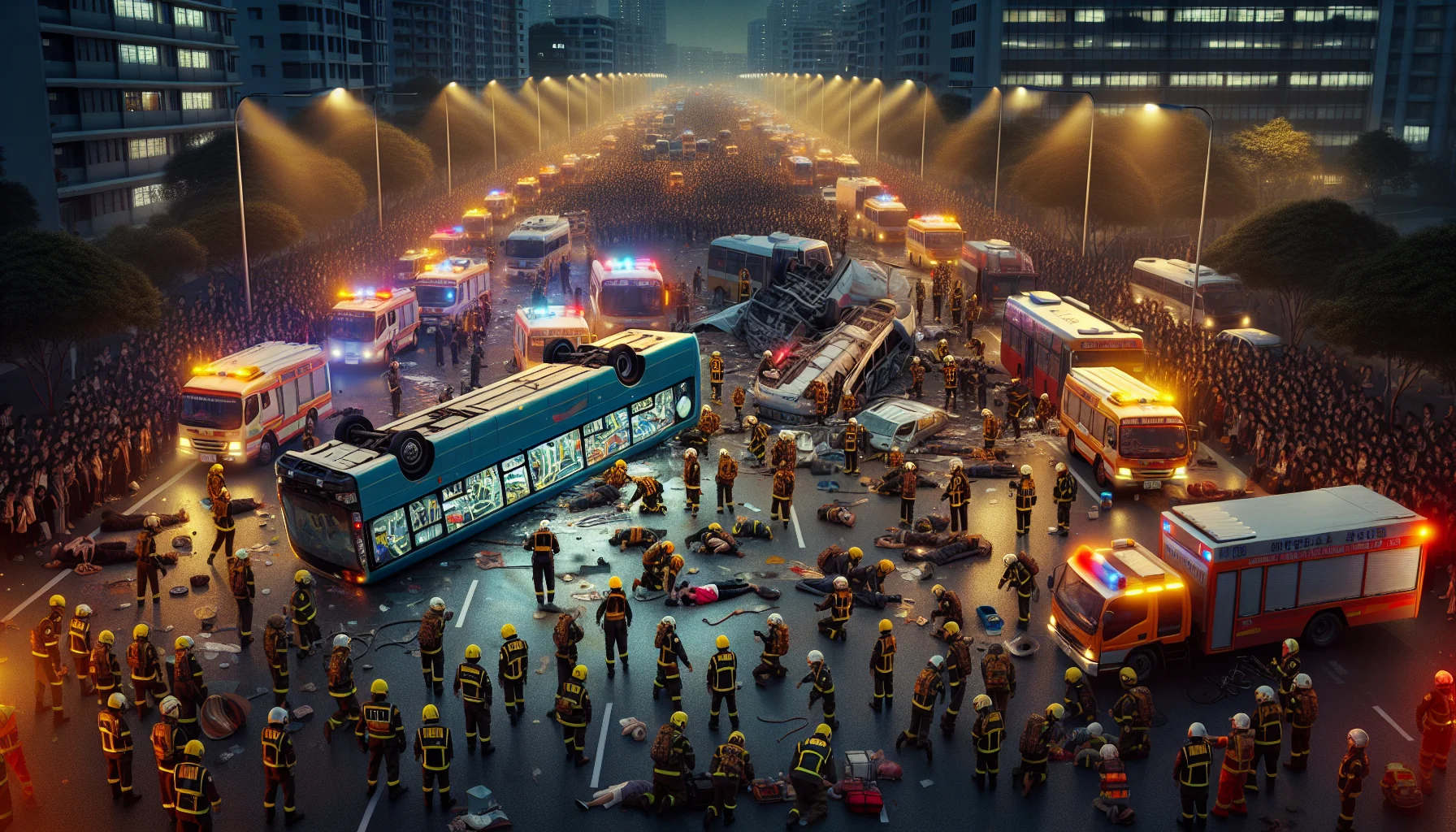
The 2018 Hong Kong Bus Accident
by: The Calamity Calendar Team
February 10, 2018
Setting the Stage
Amid the bustling cityscape of Hong Kong, public buses form the backbone of daily commutes. Residents rely heavily on these networks, threading through the city's vibrant neighborhoods and connecting lives from sunrise to dusk. February 10, 2018, was a day like many others—brimming with festive energy as racegoers filed into Sha Tin Racecourse. However, this ordinary day turned tragic, marking one of the city's most devastating bus accidents, forever altering perceptions of public transit safety.
The double-decker bus, identified as Kowloon Motor Bus (KMB) Route 872, was packed to the brim with passengers returning from race events in Sha Tin. As part of special services provided during popular racing weekends, the route was familiar, yet amid latent concerns about driver fatigue and bus maintenance, this particular trip was fraught with foreboding tension.
The Journey from Sha Tin
Seating itself comfortably among honking traffic and quiet skies, the bus departed the vibrant Sha Tin Racecourse during the lively rush of race-day departure. Set for Tai Po, passengers chatted excitedly, their voices mingling with the rhythm of the journey. However, as the bus moved through the city's veins, apprehension simmered beneath the surface. Reports of driver frustration over aggressive schedules whispered among communities like urban legends—quiet yet unnerving.
As the sun dipped lower and the shadows lengthened, the weather fell perfect—warm and inviting. Amid the weekend hustle, though, the bus became a critical player in an event that would test the resolve of the city’s emergency services and transportation authorities.
A Turning Point
About six o'clock in the evening, the bus rode down the familiar slopes near Tai Po Road, Tai Po Kau. The dimming skyline cradled the city, and headlights cut through the emerging night. It was at this crucial juncture, however, that the routine journey veered into calamity. Sudden turns, the slope’s deceptive ease, and bursts of acceleration combined—a storm gathered in the microcosm of Route 872.
As the bus descended, passengers felt an unsettling thrill cut through calm chatter. The bus swerved sharply, gripping loose against the asphalt. Tension crept into the carriage, a shared silence echoing the collective intake of breath. Faster and faster, the vehicle lost its balance, wheels skidding against the tilt of miscalculation. In seconds that felt eternal, gravity played its cruel hand—the bus veered uncontrollably, turning over on its side with sickening finality.
Thanks for subscribing!
Chaos in the Wreckage
Within moments, shock transformed into chaos. Passengers, many trapped by seats turned merciless or windows resistant to escape, called for help, their voices mingling with the growing dread filling the evening air. Flashing lights painted the smoke-engulfed scene, as the specter of tragedy took tangible form in the screams and clatter of metal against concrete.
Emergency services, honed by the rhythm of urban urgency, answered with swift precision. Firefighters, police, and medics converged on the scene, united in purpose and clad in the resolve measured by years of training. The night flickered with lights—red, blue, and the rawness of human effort—as responders began the difficult task of extracting passengers in dire need of assistance.
Responding to the Crisis
The accident’s toll was heartbreaking—19 people lost their lives in the chaos, comprising 17 men and 2 women. Scores more sustained injuries ranging from severe to critical, their futures now shadowed by the specter of the crash. For days and nights, hospitals became havens of healing, attempting the near-impossible task of stitching broken lives back together.
The fallout from the tragedy extended beyond personal devastation. Public confidence wavered, a community once synchronized in its reliance on buses now doubting the systems designed to serve. Calls for accountability grew louder, their echoes resounding in community forums and newspaper editorials.
Seeking Answers and Accountability
Amidst the public outcry, Hong Kong's Chief Executive, Carrie Lam, demanded immediate investigations, emphasizing the importance of discovering root causes and instituting reforms. Kowloon Motor Bus, its practices now under the microscope, faced intense scrutiny. Citizens and officials sought explanations, demanding measures that would restore faith and ensure the tragedy would not recur.
Investigations were comprehensive, peeling back layers of operational protocols and delayed maintenance. Driver conditions—pressing work hours, insufficient breaks, and the intense pressure of keeping up with tight schedules—were revealed as areas necessitating urgent reform.
Towards a Safer Future
In the years following the accident, significant efforts were directed towards transforming public transportation safety. Policy makers initiated updates to legislation addressing driver fatigue, instituting regulations that mandated rest periods, speed monitoring, and enhanced driver training programs.
Kowloon Motor Bus and other operators incorporated measures to prevent similar tragedies—installing monitoring technologies, assessing route risks with greater diligence, and fostering a cultural shift focused on safety over speed. Public transport systems, once a symbol of dependence marred by circumstances, became subjects of improvement and learning.
An Ongoing Legacy
Though the years have passed, tales of the 2018 Hong Kong Bus Accident resonate through time, urging a collective commitment to safety and vigilance. Beyond the city's immediate borders, urban environments around the world have adopted Hong Kong’s lessons, presenting the case as a crucial study marking the intersection of human error and disaster prevention.
This tragedy remains a solemn reminder of the responsibilities held by both operators and passengers, drawing on experiences to shape a safer tomorrow. In a bustling metropolis where cement, steel, and humanity converge, the echoes of February 10 are heard in passages between stations, in the care taken with every journey, and in the shared hope of a future without the shadow of preventable catastrophe.
Stay in the Loop!
Become a Calamity Insider and get exclusive Calamity Calendar updates delivered straight to your inbox.
Thanks! You're now subscribed.